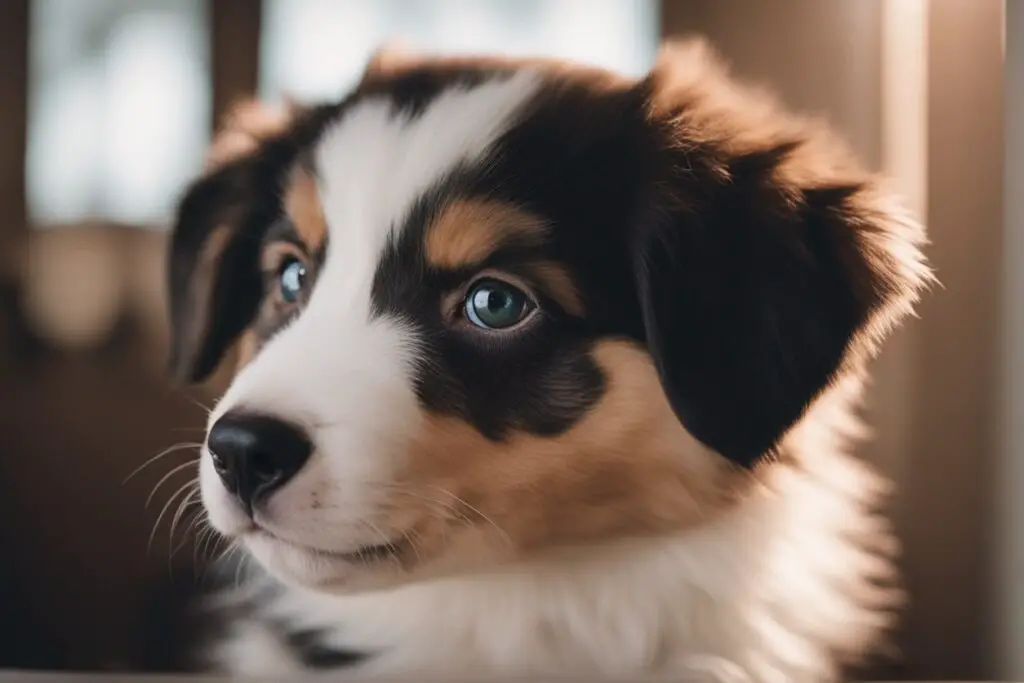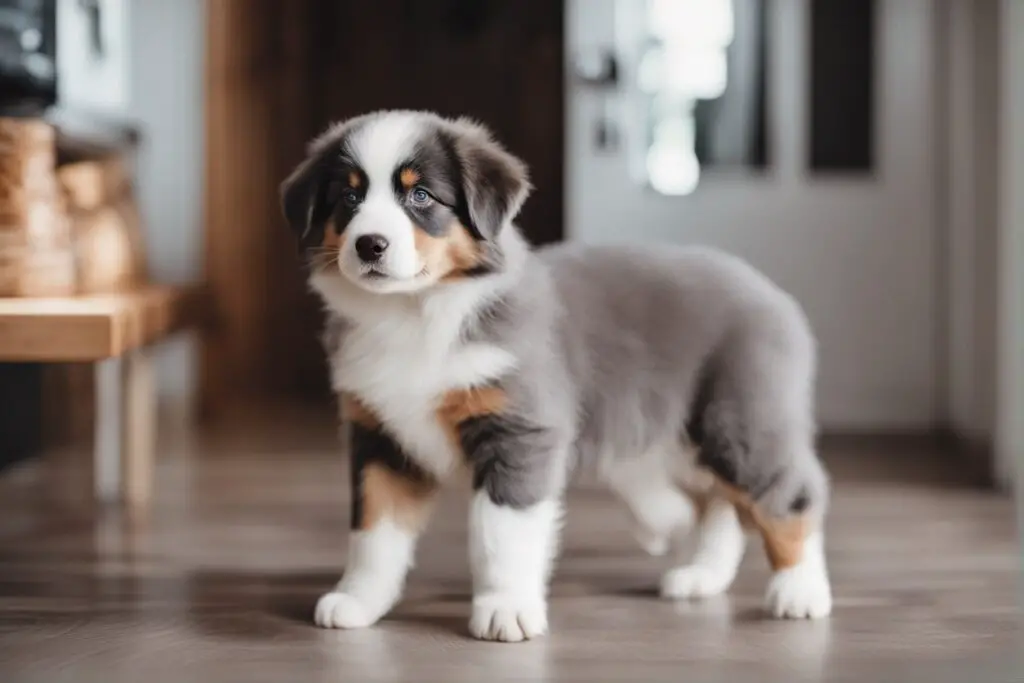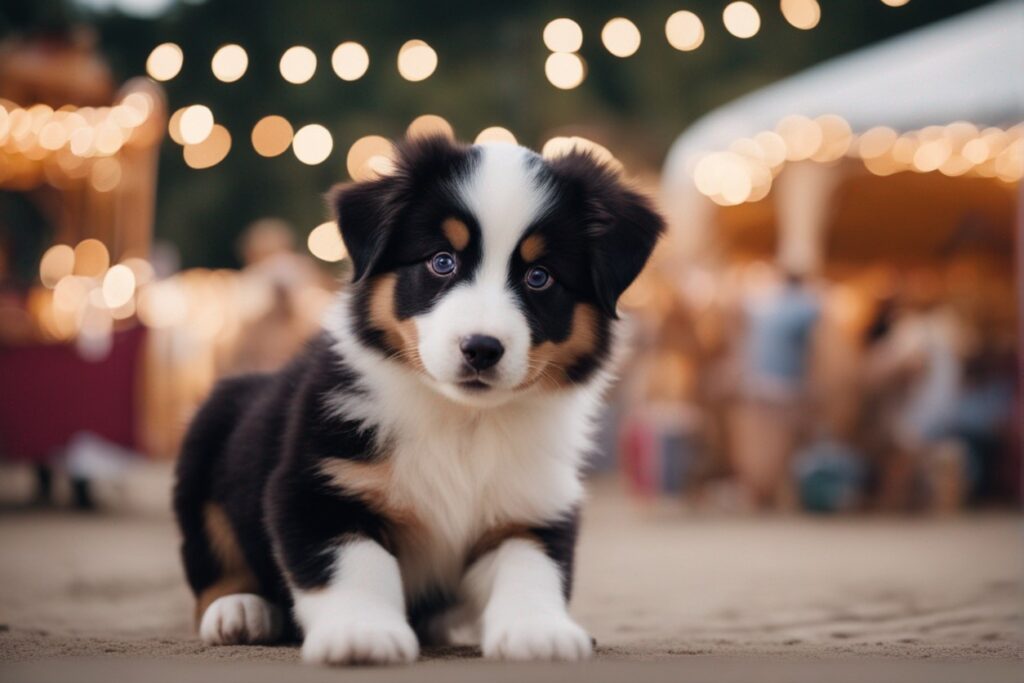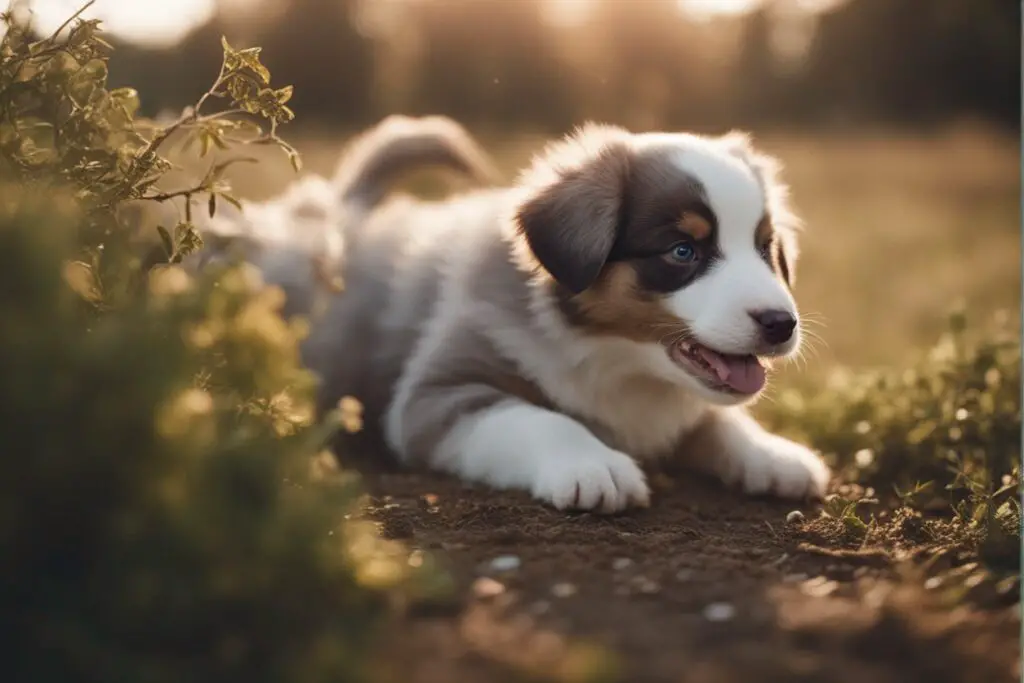Have they ever wondered why Aussie Shepherds come in such a stunning array of colors? It’s all down to genetics! From the classic blue merle to the rare white dogs, these breeds exhibit an impressive color palette. Understanding their coat colors can be fascinating for a pet owner or someone who loves dogs.
And guess what? There are standard and non-standard colors too! But don’t worry if you’ve never heard about them before. By the end of this read, you’ll have a good grasp of the subject. So let’s dive into the colorful world of Aussie Shepherds!

Table of Contents
- 1 Standard vs. Non-standard Aussie Shades
- 2 Decoding Australian Shepherd Color Genes
- 3 Aussie Solid Colors: Black and Red
- 4 Exploring Bicolor and Tricolor Variations
- 5 A rarity in Aussie Colors and Markings
- 6 Unveiling Eye Color Variations
- 7 Wrapping Up Aussie Colors
- 7.1 Does an Australian Shepherd’s color affect its personality?
- 7.2 Are some Australian Shepherd colors rarer than others?
- 7.3 Can two Australian Shepherds of the same color have puppies of different colors?
- 7.4 Do Australian Shepherds change color as they grow older?
- 7.5 Is there a link between an Australian Shepherd’s eye and coat color?
- 7.6 Are certain health issues associated with specific Australian Shepherd colors?
- 7.7
- 8 Related posts:
- 9 Do Australian Shepherds Like Water? Discover Their Swim Skills!
- 10 Australian Shepherd Puppies (25 Cute and Cuddly Pups)
- 11 10 Australian Shepherd Life Hacks: Save Time & Stress
- 12 10 Essential Training Tips for Australian Shepherd Owners
Standard vs. Non-standard Aussie Shades
AKC-Standard Colors
The American Kennel Club (AKC) recognizes four standard colors for Australian Shepherds. These are:
- Blue merle
- Red (liver)
- Black
- Red merle
These shades are the classic, most common ones on an Aussie.
Non-standard Colors
Now, let’s chat about non-standard or rare color variations. Some Aussie rock shades that the AKC doesn’t recognize. Examples of these include:
- Sable
- Yellow
- Brindle

These colors might be rare, but they’re just as beautiful!
Color Impact on Breed Standards
So, why does it matter if color is standard or not? Well, breed standards exist to maintain the health and look of a breed. If an Aussie isn’t one of the standard colors, it doesn’t mean there’s anything wrong with them! It simply means they can’t compete in AKC shows.
Remember, whether your Aussie sports a standard shade or rocks a non-standard hue, their personality, and loyalty don’t change!
Decoding Australian Shepherd Color Genes
The Gene Game
Breeders know it’s all in the genes. Dominant and recessive genes play a significant role in determining the coat color of an Australian Shepherd.

- Dominant genes overpower their recessive counterparts.
- Recessive genes only show up when there’s no dominant gene around.
The locus gene is like the switchboard operator, directing where colors go.
Paint by Numbers: Gene Combinations
Different shades aren’t just luck of the draw – they’re science. It’s all about how those dominant and recessive genes pair up:
- Two dominant genes = dark color
- One dominant, one recessive = medium color
- Two recessive genes = light color
It’s like mixing paint – different combinations give you different results.
The Merle Effect: Pattern Variations
Ever seen an Aussie with a patchwork coat? That’s thanks to the Merle gene:
- Single merle gene: Creates lighter patches throughout the skin.
- Double merle gene: Leads to larger areas of white.

So next time you’re admiring an Australian Shepherd’s unique colors, remember – there’s a lot of genetics behind those beautiful coats!
Aussie Solid Colors: Black and Red
Base Coat Colors: Black & Red
The Australian Shepherd breed’s black Aussie and solid red are two standard colors. The black coat, a solid color, is pure dark with no gray or silver hints. The red Aussie, on the other hand, can range from light cinnamon to liver but never turns into a fiery red.
- Black Aussies: A black dog has a solid black coat not mixed with any other color.
- Solid Red Aussies: This shade ranges from light cinnamon to liver.
Genetics Behind the Colors
The genetics of these solid shades are fascinating. A dominant gene influences the black color in black Aussies. For reds, it’s a recessive gene that comes into play.
- Black Tri and Black Bi: Both have the dominant gene for a black coat.
- Red Tri and Red Bi: They carry the recessive gene for the solid red color.

Common Markings
Markings seen with these solid colors include white or tan spots known as “points” These points usually appear around the chest, face, legs, and underparts of black and red Aussies.
- Points on Black Aussies: White or tan spots on chest, face, legs
- Issues on Red Aussies: White or tan markings often found on similar areas as their black counterparts
So next time you see an Aussie – be it a black tri, red tri, black bi, or even one with just some simple red spots or black spots – you’ll know there’s more to their stunning coats than meets the eye!
Exploring Bicolor and Tricolor Variations
Bicolor Aussies Uncovered
Bicolor Australian Shepherds, or Aussies, are a sight to behold. They’ve got two distinct coat colors. Usually, the base color is either blue or red. But here’s the twist – they sport white or tan markings that create a striking contrast. Some colors even have spots or highlights in their coat, adding an extra layer of beauty.

- Red Bicolor: Red base color with white trim
- Blue Bicolor: Blue base color with tan highlights
Tricolor Aussie Magic
Tricolor Aussies take the color game up a notch. These dogs flaunt three different hues on their coat. The combinations vary from one dog to another. It’s like each one is wearing a unique piece of art! You might see marbled coats, brindle patterns, and more.
- Yellow/Blue/White: Yellow base color with blue spots and white trim
- Brown/Red/White: Brown base color with red highlights and white trim
The way these colors arrange themselves on an Aussie’s coat isn’t just random chance; it’s all about genetics and breeding.
So whether you’re staring at a bicolor or tricolor Aussie, remember this – every single one is unique.

A rarity in Aussie Colors and Markings
Aussie colors can be a natural rainbow. Yet, some shades are as rare as a hen’s teeth. For instance, blue and sable Aussies are not your everyday sight.
- Blue Aussies: Blue isn’t typical for an Aussie coat. But when it happens, boy, does it turn heads! It’s like spotting a unicorn.
- Sable Aussies: Sable is another unusual color that makes you do a double-take. It’s like the dog version of having ginger hair!
Let’s discuss unique markings, specifically ‘ghost’ or ‘phantom’ merles. These aren’t Casper the friendly ghost; they’re more like genetic surprises!
- Ghost Merles: They’re red or white Aussies with faint specks of grey or silver – just like a phantom!
- Phantom Merles: These fellas have patches of different colors mixed into their coats – like they’ve been tie-dyed!

But what makes these colors and markings so rare? Well, it all boils down to genetics.
- Heterozygous merles carry one copy of the merle gene, resulting in lighter areas throughout the coat.
- Double merle is when both parents pass on the merle gene,, often leading to excessive white markings.
Finding an Aussie with these uncommon traits can be challenging but not impossible! A reputable breeder could help you find your dream doggo with tan markings or even a white patch spot.
Note: Always remember to put health above appearance when choosing your new furry friend!

Unveiling Eye Color Variations
Standard Eye Colors in Aussies
Australian Shepherds, or “Aussies,” have a fascinating range of eye colors. The most common are:
- Brown eyes
- Blue eyes
- Hazel eyes
These colored eyes add to the unique appeal of this breed.
Heterochromia in Australian Shepherds
Heterochromia, or having two different colored eyes, is another intriguing feature prevalent among Aussies. It’s not unusual to see an Aussie with one brown eye and one blue eye! This variation adds a splash of uniqueness to their face.

Connection Between Eye and Coat Color
The pigmentation that gives color to an Aussie’s coat also impacts its eye color. Here’s how it works:
- Light-colored coats often result in lighter eye colors like blue or hazel.
- Darker skin can lead to darker brown eyes.
But remember, there are always exceptions! An Aussie’s nose might be dark while its eyes shine bright blue.
Wrapping Up Aussie Colors
Well, there you have it! Every hue and shade that makes our beloved Aussies the vibrant, diverse bunch they are. We’ve covered the whole rainbow from standard to non-standard shades, solid colors to bicolor and tricolor variations. And let’s not forget those mesmerizing eyes! No wonder these dogs are such a hit – their colors alone could win any popularity contest!

So next time you’re out with your Aussie or planning on adding one to your family, take a moment to appreciate their unique coat. Better yet, please share this article with other Aussie lovers so they can get in on the color fun too! Remember, every Australian Shepherd is a masterpiece of nature. Go ahead and celebrate your Aussie’s color diversity!
Does an Australian Shepherd’s color affect its personality?
Nope! An Aussie’s color has no bearing on its personality or behavior. They all share the same lovable traits regardless of their coat color.
Are some Australian Shepherd colors rarer than others?
Yes indeed! Red Merle and Blue Merle Aussies are less common than their Black Tri and Red Tri counterparts.
Can two Australian Shepherds of the same color have puppies of different colors?
Absolutely! The genes each parent carries determine the potential colors of their pups.
Do Australian Shepherds change color as they grow older?
Aussie pups may darken or lighten slightly as they mature, but their primary coat color remains constant.
Is there a link between an Australian Shepherd’s eye and coat color?
Not really. While it’s more common for Merles to have blue eyes, any Aussie can sport this striking feature regardless of coat color.
Are certain health issues associated with specific Australian Shepherd colors?
Merle Aussies are more prone to deafness and blindness, but responsible breeding practices can help prevent these issues.